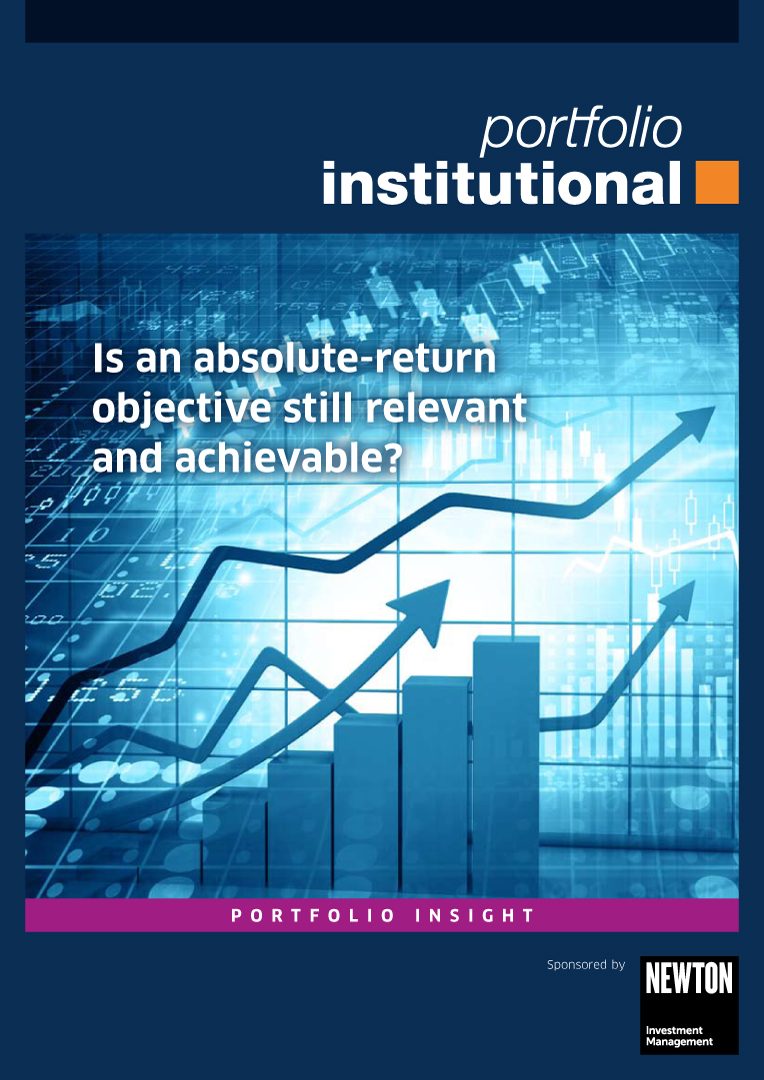Absolute-return funds were in vogue following the financial crisis as cash-hungry pension schemes chased a specific return in a low-yield environment. The promise of low volatility also appealed. But it’s a different story today. Investors have pulled billions of pounds from such funds in recent years as performance has been disappointing. Quantitative easing didn’t help.
Yet with a slowdown in the global economy predicted and central banks starting to unwind their balance sheets, do multi-asset and multi-faceted strategies have a role to play in institutional portfolios? We spoke to Newton Investment Management to find out what benefits such a strategy could bring.
Is an absolute-return objective still relevant and achievable?
Suzanne Hutchins, investment leader, Newton Real Return team
Strategies which have non-investable, cashplus targets as their benchmark, such as absolute-return and diversified growth funds (DGFs), have in recent years become part of the institutional investment landscape, gaining particular popularity in the wake of the 2007-2008 global financial crisis.
Such strategies encompass a disparate range of approaches. Some are managed more like hedge funds; others are relatively complex vehicles with derivatives and synthetic exposures; others are more akin to traditional balanced portfolios. They typically share an objective of seeking to participate to some extent at times of rising asset prices, while limiting drawdowns and volatility. In considering why, in the aftermath of the financial crisis, investors thought that absolutereturn strategies were a useful addition to their asset distribution, one needs to recall that a decade ago it looked as if the investment world had changed irrevocably. Future expected returns appeared likely to be more muted, with clients no longer able to rely on the equity market ‘trend being their friend’.
This seemed to necessitate an active, flexible approach to investment management, and a focus on an upward-only target rather than a relative benchmark in relation to which capital preservation is typically not an aim.
As it turned out, the credit crisis was in fact the catalyst for an historic bull-market run. Low interest rates (and sometimes zero interest rates), negative interest rates and quantitative easing have suppressed the yields of traditional ‘safe-haven’ bond investments, encouraging investors to migrate into riskier assets, with policymakers hoping that this would reflate the real economy.
This is generally the phase when vested interests pronounce that ‘this time is different’.
Against this backdrop of a relentless ‘hunt for yield’, and despite a number of subsequent scares, investors in risk assets have enjoyed one of the longest economic cycles in history, with strong returns available from a portfolio of global risk assets, particularly when viewed from a weak currency base such as sterling. For example, the MSCI All Countries World index has returned around 13% per annum in sterling terms during the past decade, but such asset-price inflation has not been limited to equities. High-yield credit has experienced similarly robust returns over the same period, while various bubbles have formed in assets such as property, commodities, and even cryptocurrencies. Given this recent ‘super-normal’ return experience, it is perhaps not surprising that investors question the utility of strategies which aim to limit risk of capital loss and target a cashplus return.
WHERE ARE WE NOW?
However, in an investment environment that remains increasingly uncertain and distorted, can such super-normal returns be sustained? We would contend that the current backdrop has a ‘late-cycle’ feel. This is generally the phase when vested interests pronounce that ‘this time is different’. Well this time is certainly unusual, in that monetary support for markets has become a permanent feature. If the zeitgeist of the bubble of two decades ago was the potential for a ‘technological revolution’, and a decade later it was the finance sector’s mastery of leverage, the current boom is based on central-bank policy always being on hand to support asset prices on any signs of market distress.
Our thesis remains that it is highly unlikely that the cycle has been abolished, and that the persistent stimulus over an extended period has magnified the feedback loop between the economy and the financial system.
A combination of ever-increasing debt levels (and the misallocation of capital that this implies), high valuations (implying low expected returns), investors who have been encouraged to take on too much risk, and constrained underlying liquidity suggests that even a relatively mild cyclical downturn could have an oversized adverse impact on financial markets. At the present time, major economies around the globe are facing significant headwinds, particularly with regard to global trade, in relation to which frictions, and pressure on supply chains, are intensifying. Meanwhile, the benefit of cyclical improvement in employment has already occurred.
THE CASE FOR ABSOLUTE RETURN
In our view, the challenge for all investors’ returns remains how this cycle ultimately unfolds. As already noted, we strongly believe that persistent cheap money has ‘costs’ in terms of distortions. This throws up the prospect of much lower (or even negative) returns in the short term but would also present opportunities and significantly improve the longer-term expected return for those investors who can preserve capital and be patient.
The challenge for the absolute strategy is to beat an upward-only target (which, importantly, is not investable in passive terms) in the longer term. Whereas relative investors tend to be fully committed at all times, the absolute strategy will attempt to balance participation (in a whole range of asset classes) and capital preservation in a dynamic way through the cycle. The key aim is to create an asymmetric return profile by capturing some upside and dampening the drawdowns that are so damaging to the arithmetic of longer-term returns. An unconstrained multi-asset, global and highly active strategy has the ability to be tactically flexible and opportunistic in a way that those strategies that rely principally on passive diversification cannot. Structuring a portfolio around a stable core of predominantly traditional return-seeking assets and an insulating layer of ‘stabilising’ assets can help to set a balance between participation and capital preservation, with the aim of maximising the upside potential when markets rise, while limiting the downside risks when they fall.
As it turned out, the credit crisis was in fact the catalyst for an historic bullmarket run.
THE TOOLS IN THE TOOLBOX
In addition to global equities, a dynamic absolute-return strategy can be exposed to a broad range of assets in the ‘risk space’, including corporate credit and emergingmarket sovereigns. ‘Alternative’ investments such as infrastructure, renewables, real-estate investment trusts and aircraft leasing can provide uncorrelated return streams. Following a holistically constructed single-portfolio approach, based primarily on holdings of individual securities, means there is no obligation to invest in all asset classes at all times. Instead, one can take a selective and specific approach to investment in different asset classes on the basis of their underlying investment characteristics. It is possible to alter the ‘style’ or characteristics of positions in an asset class as the backdrop changes, rather than just the weights. Likewise, ‘wish lists’ of attractive securities can be activated when price levels change.
‘Stabilising’ assets in a portfolio can be used either to dampen or increase the volatility and perceived equity risks, based on the stage of the market cycle. Derivatives such as short futures can be used as a direct hedge and can be accretive to returns in periods of market stress. Government bonds can be positioned as an indirect hedge to falling equity markets, while precious metals such as gold could provide a safe haven during tough economic times. In summary, we would contend that the flexible nature of such a strategy enables clients not just to access different return sources within a single portfolio, but also to benefit from the ability to navigate a challenging market backdrop as the potentially toxic combination of deteriorating fundamentals and lofty valuations threatens major drawdowns in asset prices. Such a strategy could be used as an insurance policy and a diversifier, while it could also be used tactically as part of an overall portfolio allocation to adjust risk levels, without giving up the optionality on sizeable capital growth through the cycle.
How to build a real return portfolio
Suzanne Hutchins, leader of Newton Investment Management’s Real Return team, discusses her attitude to risk, the importance of ESG, and why she is not happy unless the team challenges her views.
How is Newton’s Real Return strategy relevant for pension schemes?
The strategy is a good way to diversify sources of return. There is also a capitalpreservation balance to the objective, which in elevated markets provides the potential to access return in a lower-risk way to avoid large drawdowns.
The strategy is multi-asset and multi-faceted, and draws upon a broad opportunity set. We are not subject to a benchmark where we are forced to invest in certain areas of the market. It is a ‘go-anywhere’ portfolio, which means we can focus on our analysts’ opportunity ideas and a theme-based approach, as well as avoiding areas of the market that we do not like. We are aiming to deliver a return of LIBOR + 4% on a rolling five-year basis, and to preserve capital with low volatility. This is not a return stream you can just buy off the shelf because the benchmark is un-investable, which creates its own challenges.
A lot of managers think about risk in terms of volatility, whereas we assess the probability of permanent loss of capital from each individual investment.
The toolkit is broad; it’s not just equities and bonds. There are alternative strategies, such as aircraft leasing, infrastructure, renewables, liquid real-estate exposure, gold and derivatives for example, which can help to protect capital, and which clients might not otherwise be able to access. There is also a rapid implementation to the strategy at times. The dynamism makes it versatile. It is not something that can be easily mirrored by an ETF.
With the strategy being unconstrained, how is risk managed?
We embed risk throughout our entire investment process. A lot of managers think about risk in terms of volatility, whereas we assess the probability of permanent loss of capital from each individual investment.
So the starting point of the process when thinking about risk is defining what the objective is. This is a portfolio that is trying to generate a return and to preserve capital over a cycle, so we are talking about a long period. It will fluctuate from week to week or month to month.
Then you have the opportunity set. There is a lot of rigour and discipline, with each security recommended by our analysts.
Knowing what you own and why you own it is pertinent to understanding the risks being taken. You need to research a security’s business model, cash-flows, balance sheet, how the business will perform in particular environments, and what the downside and upside potential is. Putting that together in a portfolio that has a stabilising layer around the core could then take out some of the risk.
If, for example, you have a lot of equities in the portfolio and want to take out some of the market risk, you can use short futures or option strategies. If you have a fair amount of duration in the portfolio through government bonds, and want to hedge for some potential outcomes, such as a change in central-bank policy, the stabilising layer can reduce risk through buying put options on a bond future.
The way we construct portfolios, with core and stabilising layers, is built around Newton’s opportunity ideas and what the big structural trends are. Many of the growth opportunities remain in technology, the cloud, demography (demand for savings for retirement and health-care provision and population growth in China and India).
Environmental, social and governance (ESG) issues and the whole sustainability angle is a force to be reckoned with and is going to drive trends and growth in certain areas of the market.
You need to understand the risks and opportunities, and avoid the areas that you do not want to invest in, and then size each position in terms of the risk contribution from that security, in terms of what else you own in the portfolio, the liquidity of it and what it brings to the portfolio’s overall construction.
With heightening concerns over market liquidity, how would the strategy cope ‘when the music stops’?
We have deliberately created a portfolio where we want to be invested in securities that have daily liquidity, are valued daily and exchange-traded.
In essence, everything is liquid. We are not going into private equity holdings or assets that cannot be independently priced on an exchange. Of course, depending on market cap and the type of investment, some securities will inevitably be more liquid than others, but even the strategy’s alternative investments such as renewables and infrastructure are held via listed investment trust vehicles, which provide access to these assets in a transparent and tradeable manner.
We own gold because we are living in a topsy-turvy world of quantitative easing, and no one really understands what the consequences of that policy will be.
As leader of the Real Return team, how do you ensure that you maintain the right mix of capabilities and talent?
The behavioural side of the investment approach is a major consideration in our investment decision making and should not be underestimated.
First, there are nine of us in the Real Return team, so it is a broad, deeply resourced team. On top of that we have the experience of around 60 other investors at Newton who contribute to the process.
The Real Return team come from different walks of life, different age groups, genders and experience. It is important as the team leader to maintain balance but also to create challenge and debate in an open environment where people are not frightened to express their views.
Because it is a multi-asset strategy one person cannot be an expert at everything. Each team member has their area of expertise – it could be equities, bonds or derivatives. The lead managers – Aron Pataki, Andy Warwick and I – are ultimately responsible for the overall capital allocation of the portfolio.
Some of us are more focused on the shorter term and technical aspects, and others on the broader, bigger picture. Some have cups that are half full, while others have cups that are more half empty.
We hired Andy Warwick from BlackRock about 18 months ago. His different perspective is important because you constantly need to challenge your own views, challenge your approach, see if there is anything better out there and learn from others.
What role does gold play in the portfolio?
Gold has been a part of the portfolio since the financial crisis. We access it through mining equities and physically by owning an exchange-traded commodity (ETC) fund.
We own gold because we are living in a topsy-turvy world of quantitative easing, and no one really understands what the consequences of that policy will be.
What we do know is that paper money can be manipulated through printing and does not have a ‘real’ value, unlike gold which has a finite supply.
Gold can also be a good inflation hedge and also be useful when real rates are in decline. It can also perform differently to other assets in the portfolio, providing a good hedge in challenging market conditions.
Is it possible to manage such a strategy with an ESG or sustainable tilt?
I know ESG is fashionable, but Newton has always integrated environmental, social and governance considerations in its portfolios, including the Real Return strategy. We do not screen out stocks; rather, ESG is part of our risk-management process when making investment decisions. We have a group of ESG analysts who work alongside our industry analysts to rank securities in terms of where we see them sitting on the ESG spectrum.
You can quantify ESG as a risk factor. Take the example of a major oil spill: if a company does not make the capital expenditure, if it does not have the systems and safety procedures in place, it might improve the margins for a period of time, but ultimately there will be a liability cost.
When you are thinking about making an investment it is important to understand the ESG aspects along with all the other angles to an investment case.
Sustainability is taking ESG one step further. We launched the Sustainable Real Return strategy in April last year; it is run by the same team and has the same philosophy and approach as the Real Return strategy.
There are some hard rules. It does not invest in tobacco, for example, and any investments must be compatible with meeting CO2 emission targets and fit within the UN Global Compact’s 10 principles.
The strategy tends to focus on the more sustainable parts of the economy, such as infrastructure and renewables.
There is about 80% commonality of holdings with the Real Return strategy and it has the same objective to achieve a return of LIBOR +4% on a rolling five-year basis.





